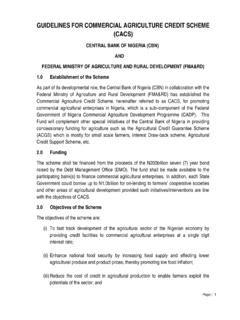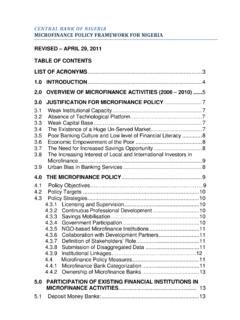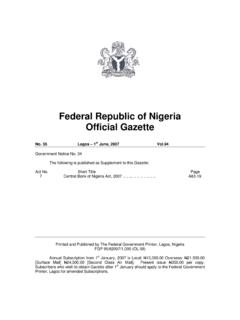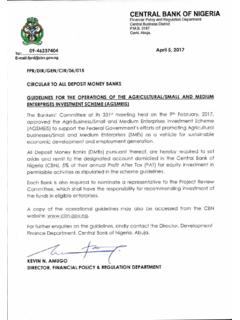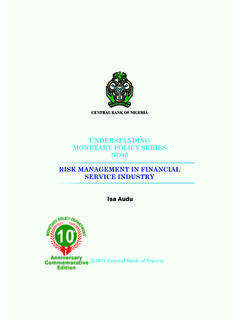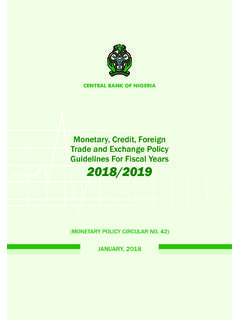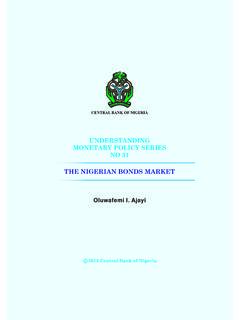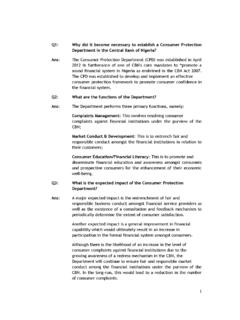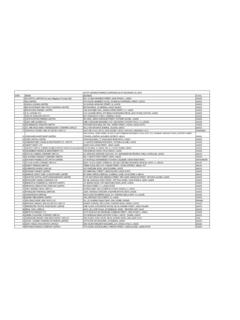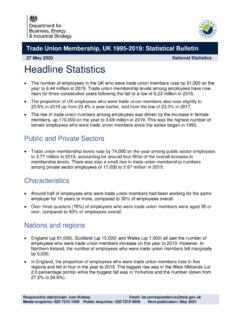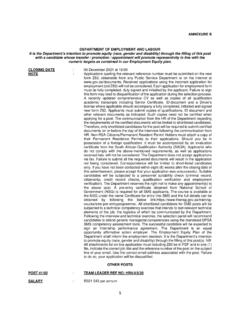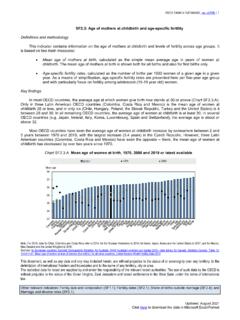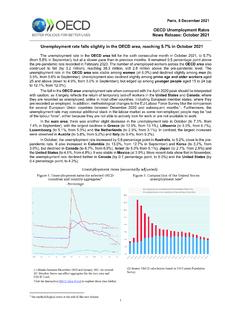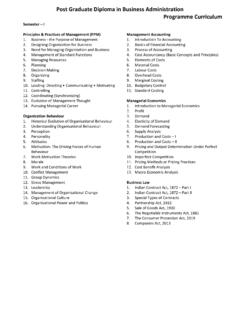Transcription of On the Compilation of Labour Force Statistics for Nigeria
1 CBN Journal of Applied Statistics Vol. 6 No. 1(a) (June, 2015) 183. On the Compilation of Labour Force Statistics for Nigeria 1. Yemi Kale and Sani I. Doguwa Computing unemployment rate using a 40 hours a week benchmark implies that any person who has worked for less than 40 hours during the reference week is considered unemployed. This method has become outdated given the present realities of the working environment in Nigeria , particularly, considering the nature of certain activities in the service sector of the economy. This document presents the new definition and revised methodology that is used to re-compute the Labour Force Statistics in Nigeria between 2010.
2 To 2014 Q4. The high rate of underemployment among age 25-34 years showcased the difficulty associated with youth and graduate unemployment. This is particularly worrisome because this category falls within the very active Labour Force population. Policies that will address youth and graduate unemployment phenomenon in the country are, therefore, required. Keywords: Labour Force Statistics , House Hold Labour Force Survey JEL Classification: E41, C22. Introduction The National Bureau of Statistics (NBS) by the Statistics Act 2007 is the National Agency responsible for developing and promoting the use of statistical standards and appropriate methodologies in the statistical system.
3 In keeping with this mandate, NBS has been carrying out on an on-going basis, methodology reviews for data production to ensure its processes are up to date and in line with international best practice, while also satisfying the peculiarities of the Nigeria 's environment. One of the critical reviews carried out recently is the definition and methodology review for the production of Labour Force Statistics , where NBS. computes the national unemployment rate. NBS has historically computed unemployment rate using a 40 hours a week benchmark.
4 This implies that any person who has worked for less than 40 hours during the reference week is considered unemployed. This method has become outdated given the present realities of the working environment in Nigeria , particularly, considering the nature of certain activities in the service sector of the economy, which presently accounts for over half of the nation's output. 1. Dr. Kale is the Statistician General of the Federation and Chief Executive of the National Bureau of Statistics , while Dr. Doguwa is the Director of Statistics Department, Central Bank of Nigeria , Abuja.
5 The contributions of other staff members from both the NBS and the CBN. are greatly acknowledged. 184 On the Compilation of Labour Force Statistics for Nigeria Kale & Doguwa As part of its strategic agenda, the Central Bank of Nigeria recently adopted the inclusion of unemployment rate in its monetary policy decisions. To this end, the Bank set up a Technical Committee comprising Statistics , Monetary Policy and Research Departments of the Bank as well as NBS to work out modalities for measurement and generation of timely Labour Force Statistics .
6 As part of the initiative to actualize this objective, a 3-day national stakeholder's workshop was organized by the NBS on the review of definition and methodology for computing Labour Force Statistics in Nigeria in September, 2014. The aim of the workshop was to deliberate on the current definition and methodology as applied by the NBS and proposed a more suitable one in line with current economic realities and international best practices. The 3-day National Stakeholder Workshop, with 18 organizations drawn from the public and private sectors, civil society organization and the media, chaired by Professor Sarah Anyanwu of the University of Abuja was held.
7 The organizations that participated in the workshop include the academia;. Central Bank of Nigeria ; Civil Society Organizations; Federal Ministry of Finance; Federal Ministry of Labour and Productivity; International Labour Office; Manufacturers' Association of Nigeria ; the Media; National Directorate of Employment; National Planning Commission; National Population Commission; Nigerian statistical Association; Nigeria Economic Society; Nigeria Institute of Socio-Economic Research; Nigeria Union of Journalist; Trade Union Congress of Nigeria ; United Nations Development Programme; and the World Bank.
8 The NBS/CBN Technical Committee organized a follow-up workshop to reflect the stakeholders' recommendations on the methodology and develop an implementation framework which outlines: (1) the modality for the conduct of Labour Force survey and (2) the possible survey frequency, amongst others. For ease of exposition, this document is structured into five sections; with section one as the introduction. The concepts and definitions used in Labour Force Statistics are discussed in section two. Section three presents the conduct of the Labour Force survey under different scenarios.
9 The earlier surveys conducted in the period 2010 to 2014 were re-analyzed and discussed based on the revised framework in section four. Section five provides summary and recommendations on the way forward. Conceptual Framework The economically active population comprises all persons of either sex who supply Labour for the production of goods and services during a specified CBN Journal of Applied Statistics Vol. 6 No. 1(a) (June, 2015) 185. period. Total Labour Force comprises members of the working age population, who during the survey reference week, were classified as either employed or unemployed.
10 These were people ages 15 and older (64 years in the case of Nigeria ) who meet the International Labour Organization definition of economically active population. While national practices vary in the treatment of such groups as the armed forces and seasonal or part-time workers, in general the Labour Force includes the employed and the unemployed. Working age population is usually resident, non-institutionalized, civilian population of Nigeria aged 15 years to 64 years. Any person in the working age population who is neither employed nor unemployed is considered as not in the Labour Force .
